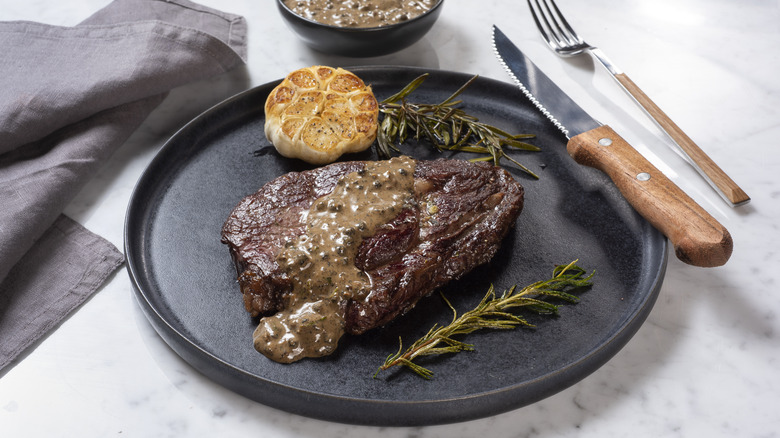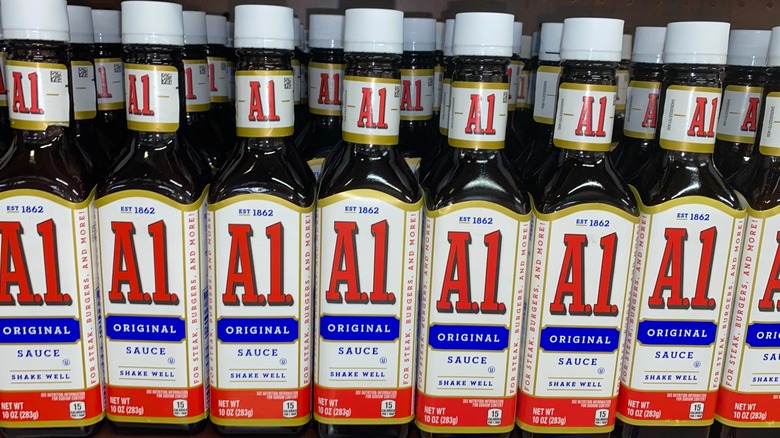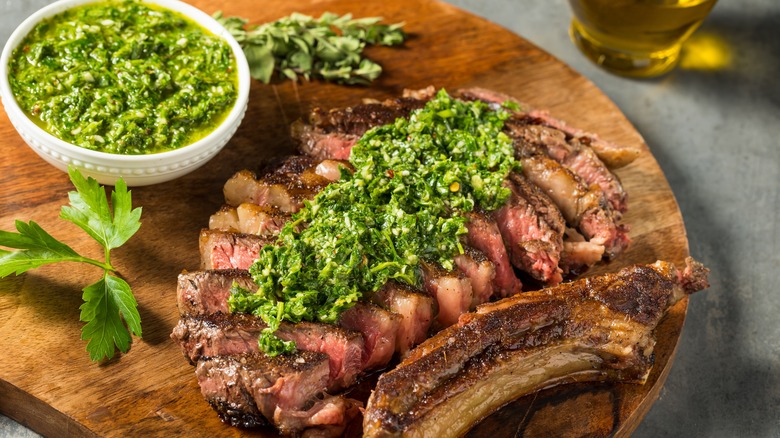Actually, There Are Times When Using Steak Sauce Isn't A Faux Pas
Steak sauce gets a bad rap, and justifiably so. A properly cooked steak isn't dry and gets enough care and seasoning during the marinating and cooking process to stand on its own. The Drover in Omaha, Nebraska, for example, has been an institution of red meat for 40 years. It soaks its steaks in a whiskey-based marinade for 15 minutes before hitting the heat to ensure it's well-seasoned, but that the meat's natural flavor isn't overpowered.
While simplicity shines when the product is top-of-the-line, not everyone can afford wagyu or has a way to dry-age a tomahawk before cooking it. A sauce is a good way to make up for that — or if you overcook a steak and the texture is reminiscent of a loafer. There's nothing worse than paying a premium for a New York strip only to have the cook hammer the thing into submission before it hits your plate.
Essentially, if the waiter or dinner host is pushing steak sauce, you might want to take them up on it. It could be that the meat has been in the walk-in too long and needs a masking agent. Alternatively, if the person ordering the steak prefers a temperature well past medium rare, the waiter might intend to offset the lack of juices with A1.
The faux pas often comes before the steak sauce
A quick preface: Chances are high-end restaurants have thought through the sauces they're offering, and it's perfectly acceptable to order one. For example, STK Steakhouse has locations across the United States and internationally. Its STK and STK Bold sauces are steak sauces, but some locations also offer Au Poivre, Red Wine, Béarnaise, Horseradish, Chimichurri, and Blue Butter sauces to accompany their cuts. Some of the sauces might be more about sizzle than substance, but the restaurant knows you're paying good money and makes an effort, rather than just dropping a condiment basket when it serves your food.
However, at your run-of-the-mill chain restaurant — which has a bevy of options and likely isn't prioritizing one menu item over another — you're probably better off ordering a burger than expecting a perfectly cooked ribeye. If you still forge ahead, and find that your steak needs sauce, something went awry long before the filet hit the table. You shouldn't feel ashamed to ask for sauce. It's not your fault the steak wasn't treated properly — but it might be on you if you ordered it cooked in a way that necessitates steak sauce. That's okay, too; just have the self-awareness to know some chefs look all the way down their noses at anyone who orders a steak well done.
So, if you find yourself in the unenviable position of asking for A1, don't be ashamed. It's not your fault. It could be the proprietor's inability to move its product, or the kitchen's error.
Dining on steak with and without sauce
There are several ways to treat a steak to avoid dousing it with sauce. Obviously, how long you cook it can affect the outcome. Marinades also infuse steaks with flavor so sauce doesn't have to, and properly resting the meat goes a long way. The way you slice it — against the grain — after 10 minutes or so helps lock in moisture that would otherwise seep out if you hack into it right off the grill.
If you're averse to things on the rarer side, your guests will thank you for lathering on a creamy mushroom or peppercorn sauce. However, the heavier the sauce, the less you're going to taste the steak. Finding the right ratio of sauce to meat, and the right sauce, serves to enhance the flavor, and can elevate your meal.
During the summer, grab some fresh herbs, garlic, shallots, and peppers, throw them in a blender with a heavy pour of olive oil, some vinegar, and a few squeezes of lime juice for a chimichurri-adjacent sauce. A nice flank or skirt steak, grilled correctly, sliced thinly, and drizzled with this accompaniment is a perfect dish for a summer night. Conversely, if it's too cold to fire up the grill, try butter-basting a steak in a frying pan for perfect caramelization with a rich finish and a nice crust. Is it still a sauce if it's not served directly with the steak? The more important question is: Does it matter?



